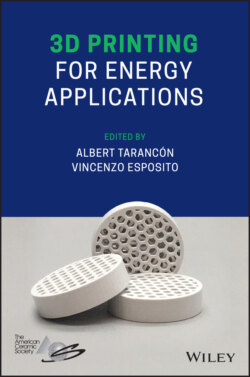Читать книгу 3D Printing for Energy Applications - Группа авторов - Страница 35
1.6 Conclusions
ОглавлениеAdditive manufacturing facilitates new ways to build functionality into metal components. The unpreceded geometrical freedom that these manufacturing technologies bring forth gives rise to new ways of considering geometry induced functionality through lattice structures, metamaterials, flexures, and topology optimization. Equally contingent is the ability to transition material composition throughout a component, either by‐layer in sandwiched gradients or in‐layer through a by pointwise material deposition. It is worthwhile to notice that despite AM offering certain new degrees of design freedom, a process inherent design constraints apply and must be thoroughly understood before embarking on the implementation of an AM infrastructure for functionally graded manufacturing of metal components. Some processes such as vat photopolymerization and laser PBF induce issues as relates to keeping process materials separated such that excessive waste is not generated during build operations. For direct energy deposition, this issue is less pronounced as segregated waste powder collection can, to a large extent, remedy cross‐contamination. Most favorable is the pointwise deposition by means of multi‐material filament extrusion and subsequent sintering. A hybrid approach where no mixed waste product is generated, yet at the cost of having a lower component fidelity as extrusion‐based AM, is limited in minimum feature size and minimum layer height. It is crucial that the benefits of AM, including geometrical freedom, digitally driven, highly agile manufacturing is weighted against the process limitations, including low throughput, process‐dependent design, and manufacturing paradigms that must be learned. Further, post‐processing of AM parts is often performed as an art form by manual fit and finishing. It can be regarded as the secret of additive manufacturing that nonchalantly by the populace is deemed a fully digital process when the underlying modality is that of a high degree of post‐processing in order to present a functional component that meets design tolerances.
The overview of recent advances in metal AM is an excellent barometer for the evolution of existing and new applications in the energy sector. The three primary drivers in favor of AM components are geometric/material functionality, lead‐time reduction, and sustainable production. The geometric functionality applied toward heat‐exchangers, topology‐optimized turbine blades, nuclear core‐reactors, etc., has the potential to be improved by the addition of material gradient functionality. Nuclear power components, steam/gas turbines components, fuel cell components, oil & gas are the major sectors in which a steady growth of critical functional metal AM components is expected over the coming decades, with an increase in available materials. Metal AM applications driven by lead‐time reduction and sustainable production are expected to have an exponential growth in the nuclear, oil & gas sectors specifically for on‐demand and on‐site production. Consolidated designs produced with AM are increasingly proving to be an efficient solution for the energy industries complex needs. Steadily the capabilities are evolving toward much higher degrees of design freedom, toward better capabilities of multi‐material manufacturing in highly dissimilar materials and for the confident and resolute, the capabilities that currently present themselves for introducing a new function to components that have the potential to have an encompassing implication to how new technology can be brought to market.
